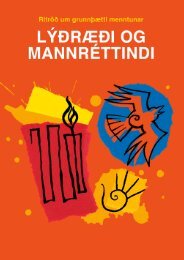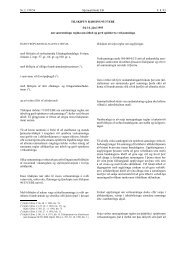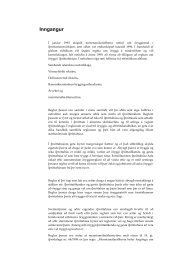Nomination of
Nomination of
Nomination of
Create successful ePaper yourself
Turn your PDF publications into a flip-book with our unique Google optimized e-Paper software.
SURTSEY – NOMINATION FOR THE UNESCO WORLD HERITAGE LIST<br />
Invertebrate diversity on Surtsey island<br />
Average number <strong>of</strong><br />
specimens per day<br />
> 300<br />
200 < 300<br />
451 100 < 200<br />
50 < 75<br />
25 < 50<br />
10 < 25<br />
Plots<br />
The results <strong>of</strong> pitfall trapping within permanent plots show that the diversity <strong>of</strong> Surtseyan invertebrates is<br />
considerably greater within the gull colony than in other parts <strong>of</strong> the island. Furthermore, the<br />
abundance, or number <strong>of</strong> individuals, is also shown to be greater (Fig 2.15).<br />
However, a few permanent plots, located in a shore community on the eastern part <strong>of</strong> the island<br />
also appear to be relatively rich in invertebrates. One <strong>of</strong> these plots is located at the helicopter<br />
platform, where gulls tend to rest and enrich the soil with nutrients. The high abundance recorded at<br />
two other sites is caused by numerous individuals <strong>of</strong> a single species, the thrip Taeniothrips atratus,<br />
which has sea sandwort as its host plant.<br />
A total <strong>of</strong> 335 invertebrate species has been<br />
found on Surtsey (Appendix 7; Table 2.6).<br />
These include arthropods, molluscs, annelids,<br />
nematodes and rotatorians, approximately<br />
half <strong>of</strong> which have become permanently<br />
established. Although flying insects are most<br />
conspicuous, soil animals are most numerous.<br />
There are as <strong>of</strong> yet no endemic invertebrates<br />
on Surtsey. One species <strong>of</strong> special interest<br />
is Ceutorrhyncus insularis, a very small<br />
38<br />
13<br />
21<br />
100<br />
Total number <strong>of</strong><br />
species recorded<br />
50<br />
235<br />
30<br />
20<br />
10<br />
0<br />
39<br />
57<br />
451<br />
72<br />
176<br />
13<br />
72<br />
176<br />
41<br />
14<br />
34<br />
230<br />
189<br />
24<br />
28<br />
146<br />
13<br />
111<br />
31<br />
19<br />
200 m<br />
The tiny weevil Ceutorhynchus insularis, which is<br />
abundant on scurvygrass on Surtsey, was first discovered<br />
in 1968 on one <strong>of</strong> the Vestmannaeyjar<br />
islands. It was originally believed to be a new<br />
species to science and was described as such in<br />
1971. Later on, similar specimens were discovered<br />
in samples from the Hebrides Islands <strong>of</strong>f Scotland.<br />
The forb-rich grassland vegetation <strong>of</strong> the gull<br />
colony supports a higher diversity and abundance<br />
<strong>of</strong> invertebrates than do other parts <strong>of</strong> the island.<br />
snout beetle that feeds on scurvy grass and is<br />
extremely rare on a global scale.<br />
The establishment <strong>of</strong> a gull colony clearly<br />
boosted the insect fauna on Surtsey (Fig. 2.15).<br />
A few species such as Atheta graminicola are<br />
completely dependent on the gull colony, even<br />
though others such as Amara quenseli prefer<br />
the harsh tephra ground elsewhere (see box<br />
on this page).



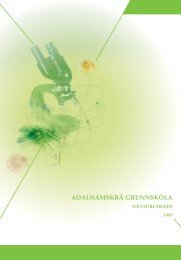
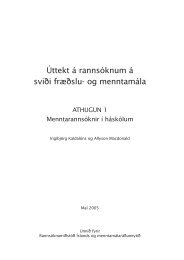

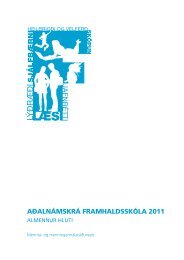
![Aðalnámskrá tónlistarskóla : rytmÃsk tónlist [Eingöngu á rafrænu formi]](https://img.yumpu.com/50843672/1/184x260/aaalnamskra-tanlistarskala-rytma-sk-tanlist-eingangu-a-rafranu-formi.jpg?quality=85)
